Introduction
Worldwide apple production has trended up since the USDA Foreign Agricultural Service (FAS) started recording production in 1970. Worldwide fresh and processed apple demand remains strong due to healthier diets and increased standards of living in developing countries.The largest global commercial apple producers for 2020-21 season were China, the European Union (EU) and the United States. China produces over half of the total global apple crop. However, China exports less than 5% of its crop, diluting its effect on global markets. The EU and United States export around 10% and 20% of their crops respectively.1
On a national scale, Washington leads production accounting for around two-thirds of the nation’s total. In 2020, Washington accounted for 70% followed by New York with 12% and Michigan with 9%.2 Washington benefits from rich soil, near-ideal fruit-growing climate – warm days and cool nights with dry summers – and sophisticated storage, packing and marketing infrastructure.
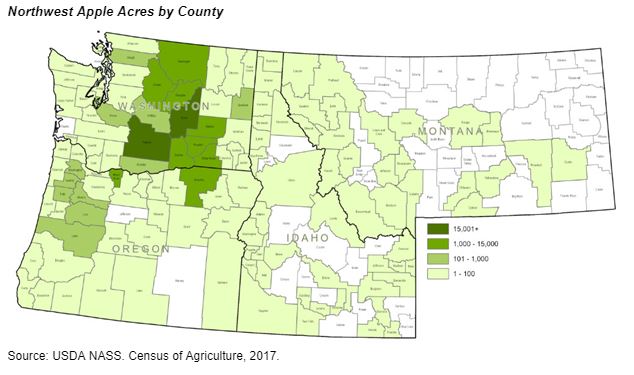
Varieties
Historically, the Red Delicious variety dominated the Northwest apple industry. However, the industry has taken heed of consumer taste preference and production has transitioned to newer apple varieties. This is evidenced by the dramatic reduction in Red Delicious production from 70% of the varietal mix in the mid-1990s to under 20% of total production today. Varieties tend to phase out of favor with consumers. Originally Fujis and Galas stole market share from Reds and Goldens. Now Honeycrisp, Crisp Pink, Ambrosia and other bi-color varieties are displacing older, less desirable varieties.
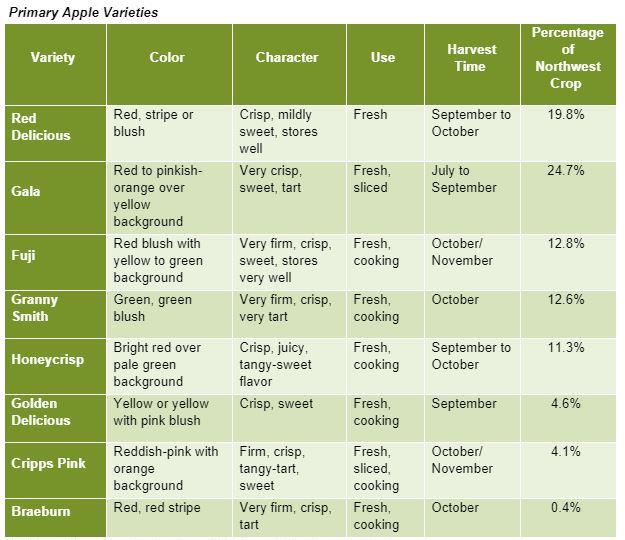
Additional information about apple varieties is available via the internet at www.bestapples.com
Source: Washington State Tree Fruit Association (WSTFA) Statistical Review 2019-20.
Club apples are controlled supply varieties and continue to grow in number and popularity. All distribution – from nursery to grower to market – is controlled by an integrated growing and marketing organization or through proprietary production, packing and marketing agreements with the patent holder. Club varieties are established to prevent oversupply of those varieties in the marketplace and enhance growers’ financial returns. Markets around club varieties are very dynamic, a good picture of the number of varieties and complexity can be found at goodfruit.com/the-club-crowd.
Washington State University developed Cosmic Crisp, one of the newest varieties, which is publicly available and therefore not a club variety. However, it is proprietary and the university has focused domestic production to Washington growers. While development of new varieties is common, Cosmic Crisp is unprecedented in its anticipated production growth. Production is expected to reach 9 million boxes by 2023, just four years after its launch. It took Honeycrisp over 20 years to reach the same production levels.
Value Chain
Growth and HarvestApple trees grow from rootstocks. Some orchards grow their own rootstock, however most rootstock is established in nurseries. Rootstock is selected based on qualities that make growth successful, such as dwarfing characteristics, anchorage and resistance to pests and diseases. Rootstock grows in the field for about a year. Then, apple tree shoots are either grafted onto rootstock and grown in a nursery until ready for replanting in an orchard. Some orchardists use a “plant in place” method where rootstocks are planted in the orchard and subsequently grafted.
Once an apple tree is planted in an orchard it is considered pre-productive until it produces a crop, generally in the third or fourth leaf3. Economic production, when the tree produces enough to cover its costs, happens approximately four to five years after being planted in an orchard. Full production happens around five to seven years depending on variables such as variety, soil and growing methods.
Growers use multiple kinds of trellis systems, which allow for high-density orchards and make apples easier to harvest. Trees are planted at various spacings, then limbs are trained on wires to fill space between trees. Trellis systems designed to create a fruiting wall are increasing in popularity since a fruiting wall allows for better control of fruit size and quality, and potentially favors mechanization. Two main trellis systems for apples are:
- V-trellises, typically built with either wood or metal posts. Spacing of posts and wires are variable as is spacing of trees planted, depending on variety and grower preference.
- Vertical trellises, typically built with wood posts and three wires. Spacing of rows and trees are variable depending on the site and grower preference.
Packers
After harvest, apples are sent to a packing warehouse where they are stored, washed, sorted, waxed, boxed and shipped. The Northwest’s two main packing hubs are in Yakima and Wenatchee, both in Washington state. Packing warehouses have two main purposes: packing and storing. Washington has the largest concentration of cold storage (CS) and controlled atmosphere storage (CA) facilities in the world.
“Pre-size” and “commit-to-pack” lines are two traditional approaches to a packing line. The pre-size line sorts by size and generally by grade. Sorted apples are placed back into bins for storage. These apples will be kept in storage until a later date that is dictated by the market and will then be sent to a dedicated packing line. Apples sent on the commit-to-pack line are taken out of storage, or sometimes from bins recently delivered from the orchard, then sorted, sized and packed into boxes ready for retail. After being packed in boxes, the fruit goes back into cold storage until shipped. Commit-to-pack systems are the industry standard today as they allow fruit to be handled once, thereby reducing mechanical external and internal bruising to apples.
Packing lines are increasingly automated, cutting down on manual labor and improving consistency in high-quality product. Due to technology upgrades, packing lines can now sort for each apple’s size, color, grade, external defects, internal condition and shape. These characteristics determine whether an apple will be fresh packed or processed. The most desirable size and color of apples will go to fresh pack and fetch the highest premiums. Apples going to processing will be less profitable. The main products for processed apples are slicers/peelers, juice and applesauce. The Washington apple industry is focused on fresh pack, and processor apples are a by-product.
Apples will be stored in CS or CA storage depending on when they will go to market. CS is traditional refrigeration; at about 33° Fahrenheit it can hold apples for up to 90 days before fruit quality is jeopardized. CA storage can preserve fruit quality for up to a year. Its reduced oxygen levels of 1% to 2% will decrease an apple’s metabolic rate to near zero.
Large-scale fruit-packing warehouses tend to be vertically integrated primarily with owned orchards or production-packing agreements with large, independent fruit growers. Vertically integrated producers have been around since the beginning of the industry. However, packing warehouses are seeing increasing advantages to controlling supply. In general, a commercial operation must handle over 150,000 bins on an annual basis to gain efficiencies from new technology.
Alignment between growers and packers is not the only place the apple industry has consolidated tasks under one roof. Several packing warehouses sell their own fruit, but more commonly multiple packers share a common fruit marketing company/sales desk.
Marketing-Sales Desks
The domestic tree-fruit market is dominated by large retail grocery chains. Chains prefer to purchase fruit from operations with the size and scope to supply a large number of stores with high-quality fruit. This has driven packing warehouses to join together at the marketing-sales desk level to collectively meet the needs of the large retail firms. As a result, the Northwest tree-fruit industry is consolidated down to less than 30 marketing-sales desks, with the 10 largest moving the bulk of the fruit produced.
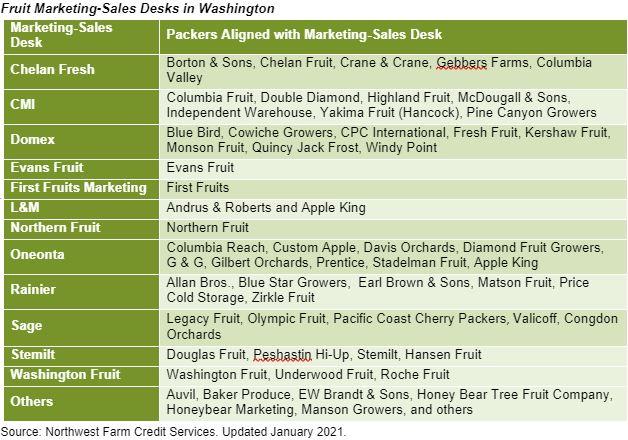
Retailers
The multiple varieties of apples command a considerable amount of shelf space. Large retailers have limited the sizes of apples that they will display and primarily focus on those that fall within the 72- to 88-size range4. These retailer-imposed size restrictions have exacerbated the marketing-sales desks’ difficulty in marketing apples with larger and smaller than desired size profiles. Smaller-sized apples are often sold domestically in bags or to export markets. Fruit packed into bags have grown in consumer popularity during the COVID-19 pandemic as consumers perceive the packed produce as lower risk of COVID-19 transmission.
Retailers have shifted a portion of their focus to club apple varieties as a means of securing a competitive advantage through diversifying their product mix. A primary concern for marketing-sales desks and producers is consumers’ acceptance of new varieties. Another issue is whether the club varieties are differentiated enough to command higher pricing necessary to offset added development costs.
Organic
Organic tree-fruit producers are being rewarded through price premiums. Therefore, retailers of all sizes try to capture a share of the organic market. Most marketing-sales desks across the Northwest have geared up to take advantage of long-term growth in this market. Currently, the Northwest produces over 15 million boxes of certified organic apples, making up 11% of the total crop.5 The Northwest has a comparative advantage over other growing regions since the dryer climate leads to fewer pest, mildew and mold issues.
Drivers
Varietal Mix and YieldA critical component driving producer profitability is varietal mix. Orchardists are replanting orchard acres to align with market demands, positioning for the highest rate of return to their operation. The cost to keep strains and varieties current with market demand is high. However, producers who have not kept pace with consumer demand are experiencing profit margin pressure given lower prices for fruit. Varietal obsolescence will be a problem for growers who do not take steps to keep up with the newest varieties. Since rejuvenation results in unproductive assets, it is recommended that growers stay ahead by perpetually keeping around 15% to 20% of acres in some stage of development at all times.
Consumer demand greatly influences varietal trends. Red and Golden Delicious apples have historically been the cornerstone of the Northwest marketplace. However, these two and older Fuji and Gala strains are losing favor in the marketplace to modern varieties such as Honeycrisp and Cripps Pink, and new strains of Gala and Fuji with favorable coloring, texture and crispness. Leaders in the industry have proactively reduced the percent of Red Delicious they grow, and some have no Red Delicious in production.
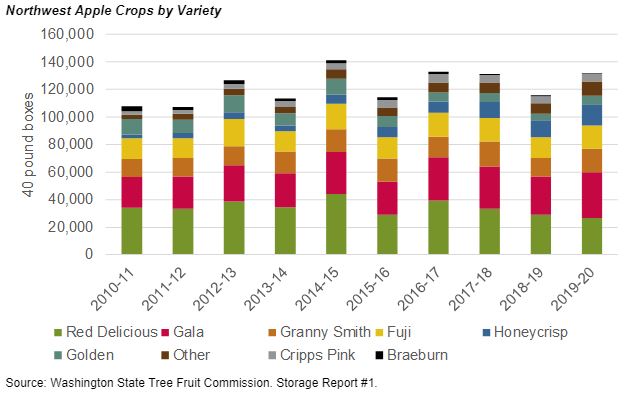
High-Density Plantings
The development of trellis systems and dwarfing rootstock enabled the tree-fruit industry’s adoption of high-density orchard plantings that increase production per acre. For example, a traditional apple orchard with freestanding trees may have a density of 500 trees per acre and yield around 40 bins per acre. An updated, high-density orchard may have 2,000 trees per acre and yield over 80 bins per acre.
Northwest apple crops have reached record levels and are expected to continue increasing as traditional orchards are converted to high-density plantings. Continued improvements in trellis systems and rootstock will also boost yields.
Labor
Finding adequate labor to meet the need of this hand harvested crop has become a notable concern. Over the last several years, orchard worker employers have found that less and less people are willing to do harvest labor. This scarcity of labor drives up costs. Growers and packers continue to look for ways to cut costs by deploying labor resources efficiently and adopting systems and practices that reduce labor needs.Sourcing Labor
In the past, orchardists have relied on word of mouth and returning workers to fill their labor needs. However, a more proactive approach is now required. Orchardists are competing for and retaining workers by raising wages, working with labor contractors and keeping well-maintained labor camps.
The H-2A Temporary Agricultural Worker program provides an outlet for attracting and retaining labor, although the program is costly and requirements are complex. Program participation requires employers to provide transportation from country of origin, housing and transportation to and from work. The employer must guarantee employment for at least 75 percent of the contracted workdays.
Impact of Growing Conditions on Labor
Compressed harvest seasons can affect the number of workers available to work within the narrow harvest window. If an entire region is experiencing a light crop, the majority of the workforce may bypass an orchard completely for more productive areas. Production can be improved through the adoption of high-density plant spacing, trellis systems and dwarfing rootstocks. These orchard additions allow workers to be more efficient in harvest, leading to increased earning potential for both the worker and the producer.
An extended bloom may lead to inconsistent fruit maturity, which can require additional harvest passes through the same acreage. Other adverse weather such as frost, excessive heat, wind, rain and hail can affect the quality of the fruit to be harvested, creating a need for intensified field sorting or selective picking. These can significantly increase labor costs and lessen profitability.
Global Trade
The bulk of the Northwest apple crops is sold in the domestic market, around 80 to 90 million boxes annually. However, as crop sizes have increased, foreign markets have grown in importance. Key foreign markets include Mexico, Canada and Asia. Foreign markets are particularly important for varieties that are not as desirable in the domestic market, namely Red and Golden Delicious.In 2017 India surpassed Canada to become the second largest importer of U.S. apples. In 2018 tariffs were implemented as part of the steel and aluminum dispute (Section 232). Large tariffs along with devaluation of the Indian Ruppee drastically reduced exports to India. In March 2021 India announced that several imported produce items, including apples, will require a non-GMO certificate. This action shut off the Indian market to U.S. apples because the USDA does not issue such certificates, even though the Washington State fresh apple industry is entirely non-GMO.
Technology
Technological advances in the apple industry are driven by the need to maximize labor and monetary and natural resources, while increasing yields and productivity. The capital cost of technology is significant, but substantial economic rewards may be reaped by producers who implement proven technologies as part of their overall business strategy.Producer
GPS and variable-rate technologies for fertilizer and water applications continue to gain acceptance among tree-fruit producers. The need for increased oversight in water management has also promoted increased use of digital drip irrigation systems that can be controlled remotely with technologies such as smart phones or tablets.
The use of shade cloth and hail netting is becoming increasingly prevalent among apple producers. A sizable amount of capital is required to implement shade-cloth systems. There are also potential problems with reduced photosynthetic activity resulting in smaller and less colorful fruit. However, benefits include increased fruit yields through consistent budding across the tree, fewer numbers of culls due to protection from heat and sun damage, and prevention of sunburn. Shade cloth eliminates the need for overhead cooling systems, which effectively reduces water requirements and the risk of microbial contamination from irrigation water.
Drone use continues to expand, improving the availability and quality of data for orchard managers. An array of camera and sensor options provides detailed analysis for soil, moisture, erosion and temperature conditions. Adoption of drone technology will likely increase in the coming years as producers increase focus on precision agriculture.
Automated picking technology has been in development stages for a handful of years. FFRobotics and Abundant Robotics are two companies actively working to commercialize a robotic apple picker. Both technologies use computer cameras and sensors to detect apples. Abundant Robotics’ prototype uses a robotic vacuum arm to pick the apples off the tree while FFRobotics’ technology has several arms with three pronged grippers for picking. These companies tested a prototype in the 2019 harvest and anticipate having larger-scale commercial prototype testing in the coming years.
Packer
Packing-line technology has expanded over the last several years to include sorting technology to detect internal defects, color and size for the apple industry, along with robotic palletizing and automated cold storage facilities. All of these technological advances serve as labor-management tools.
New sorting technology provides the ability to deliver high-quality products to the consumer while minimizing human error. Cameras and sophisticated software programs replace human defect sorting with machine defect sorting. Throughput, the amount of fruit a line can handle, is less compromised when sorting through a hail- or other weather-damaged crop. Precise sorting technology also captures any gradable fruit from a lot that would historically have been entirely culled, thereby capturing the highest possible returns for the producer.
Packing technology comes at a significant cost and requires a supply of over 150,000 bins to support the increased fixed costs. However, labor shortages are pressuring warehouses to adopt technology. The elimination of human sorters on the front end of the packing line often reduces labor needs by 30% to 40% at the warehouse. However, the savings from cutting labor costs are generally offset by increased fixed costs associated with building modifications to accommodate larger lines and increased depreciation costs.
Appendix A
Best Practices
The following summarize the best practices common among successful and progressive tree-fruit growers, packers/shippers and marketers. These primarily relate to issues of production and warehousing.
Orchard Production Best Practices
Have a strategic plan- Successful businesses have defined goals and are continually in the process of executing specific strategies in their business. These strategies may include growth (e.g., diversification, replication, integration, networking), downsizing/rightsizing or intensifying (i.e., improving efficiency).
- Growers increase gross revenue through a combination of reaping high yields, producing desirable fruit varieties and peaking on a demanded size profile. A desirable varietal mix and high-yielding orchard structures will continue to be critical to competitive top-line revenues.
- Growers manage fixed and variable expenses, which allows for lower break-even levels.
- Growers with high-density plantings and/or highly demanded varietals may have a higher cost structure than the average grower, but cost containment remains pertinent as supplies reduce prices in large crop years and the industry becomes increasingly competitive.
- Focusing on orchards of an economic size is key to long-term cost competitiveness.
- Growers achieve diversification by growing multiple types and varieties of fruit.
- Successful growers diversify, when possible, by cultivating crops in differing geographic areas to hedge against widespread weather-related adversity.
- Growers use available risk-management tools, such as crop insurance, to mitigate the risk of adverse and unforeseen events that could drastically affect the business. Crop insurance options include three variations of coverage: production based, revenue based and named peril. Most producers use some combination of these products to tailor a protection strategy that matches the specific safety needs of their business.
- Top-performing growers place their operations on a renovation schedule. To maintain the competitiveness of the orchard as a whole, approximately 15± percent of total planted acres on average may be pre-productive at any one time.
- Orchard renovation not only allows for updated orchard structure (e.g., denser plantings and/or trellis systems), but allows orchards to avoid varietal strain obsolescence.
- When their operations lack critical mass, successful producers align with other growers to attract picking crews and assure them of a consistent supply of work that extends from the start of cherry through apple harvests. Access to a dependable labor force will continue to be an important piece of orchard production going forward.
- Growers also might partner with other growers to leverage volume discounts for equipment, chemicals, fertilizers, fuel and other necessary inputs.
- Successful growers align with successful packing or storage warehouses that provide competitive services at reasonable costs. These warehouses need to have quality facilities and current fruit-handling and -packing equipment. Growers who align with successful warehouses tend to perform with more consistent profitability.
- Successful growers place fruit with packing and storage warehouses aligned with a strong marketing-sales desk. This provides ready access to large domestic and international retail markets, which translates into the most competitive returns.
- Successful fruit growers have established and implemented a labor strategy for their business that will ensure their seasonal labor needs are met.
- Progressive tree-fruit growers need to be prepared to furnish housing and year-round employment as a means of retaining key employees.
- To help alleviate labor shortages during peak harvest times, producers have begun planting several varieties at different locations or elevations. This creates varied harvest times and a steadier labor-demand window.
- Larger producers are able to move labor forces from one orchard to another over larger geographic areas to ensure the labor force is retained.
- Many producers are successfully using the H-2A Temporary Agricultural Workers program. Although somewhat expensive, the program provides a feasible solution to labor needs.
- Some producers have successfully used contractors who, for a fee, offer full-service labor. However, this practice has met some resistance, mostly because of timing and scheduling considerations.
- Development of labor-reducing or "picker-friendly" tree-planting styles is proving to be an advantage in terms of the ability to attract and retain an adequate labor supply.
- Successful operations use accrual-based reporting to assess true financial position and performance. These growers also use enterprise accounting to assess profitable and unprofitable business units, or orchard blocks.
- Orchardists with strong liquidity and lower leverage are able to absorb market down cycles and take advantage of strategic opportunities.
- A business should assess the adequacy of its financial position annually by using tools such as financial ratios, peer financial benchmarks and historical trend analyses.
- Sensitivity analysis may also be used to give an accurate picture of the true financial position of the business given possible adverse scenarios.
Warehousing Best Practices
Have a strategic plan- Successful businesses have goals and are continually in the process of executing specific strategies in their business. These strategies may include growth (e.g., diversification, replication, integration, networking), downsizing/rightsizing or intensifying (i.e., improving efficiency).
- Successful warehouses maximize the use of fixed assets.
- Improved use results in reduced per-unit costs, which enables warehouses to maintain competitive grower returns.
- Warehouses, as packing entities, must understand fixed and variable costs to maintain competitive packing charges and maximize income levels.
- Cost containment allows a warehouse to reduce the level of throughput needed to break even in short crop years when fruit supplies are more scarce than usual.
- Break-even analysis is valuable for understanding and predicting earnings based on various throughput levels at the warehouse.
- Sensitivity analysis may also be used to give an accurate picture of the true financial position of the business given possible adverse scenarios.
- Allied packing warehouses trade packing and storage capacity to use assets to their fullest potential. This situation is most often seen with warehouses using a common marketing-sales desk.
- Aligned warehouses can dedicate a specific line to a particular variety with fewer changeovers.
- Sharing and balancing storage needs, improving the variety and size profile of manifest for marketing-sales desks and working together to realize increasingly efficient logistics and distribution are inherent advantages of partnership.
- Successful packing warehouses align with marketing-sales desks that have steady access to a wide range of retail customers that use a broad portion of the total manifest, ultimately, to maximize fruit returns to the grower.
- Some integrated operations also own and operate a marketing-sales desk.
- Successful packing warehouses must closely monitor marketing-sales desk performance to ensure that competitive returns are realized on packed fruit.
- New technology, both in the field and in the warehouse, could reduce labor requirements substantially over the next five to 10 years. Specifically, such technology could include the use of platforms and mechanical harvest methods in the orchards or the increased use of robotics and digital-imaging sorters within the warehouses.
- Packing warehouses align with growers to assure their targeted product throughput.
- Integrated operations typically grow a significant portion of the fruit they pack.
- When working with retailers, value-added processes may prove to be a competitive differentiator. Such processes include inventory management, labeling, traceability programs, promotions and other value-enhancing activities.
- Warehouses with strong liquidity and lower leverage are able to weather adversity and take advantage of strategic opportunities.
- A business should assess the adequacy of its financial position annually by using tools such as financial ratios, peer financial benchmarks and historical trend analyses.
- Stress case scenarios may also be used to give an accurate picture of the true financial position of the business.
Glossary
Bench Graft. System where root stock and scion wood are grafted, shortly before the now grafted “tree” is planted in the orchard. This system eliminates the need for growing the trees in a nursery prior to planting in the orchard, however, the downside risk slower initial growth at the orchard site and potentially higher death loss.
Bin. A container that holds about 900 pounds of apples.
Bitter pit. A physiological problem with apples, seen as small, dark, rounded lesions on the skin. Caused by calcium deficiency.
Bloom. A period of time that starts with the pink set and ends with petal fall about 10 days later. ‘Full bloom’ is defined as the day that 60% of ‘king blossoms’ are open on the north (shady) side of the tree.
Blossom thinning. Removing some of the blossoms that are turning to fruit. If apple blossoms are not thinned and all fruit grows to maturity, apples are small in size and the health of the tree is stressed.
Boxes. Apples are hauled and stored in bins, but packed for shipping in smaller cardboard boxes. A box of apples is 40 pounds.
Bud. Found in the axils (the upper angle between a leaf stalk or branch and the stem or trunk from which it is growing), a bud is basically a dormant and compressed shoot, which given the right conditions will resume growth.
CA storage. Controlled atmospheric storage varies in size to hold from 10,000 boxes to 100,000 boxes. These rooms are sealed and oxygen levels are reduced by the infusion of nitrogen gas to reduce the oxygen level from approximately 20% down to 1%-2%. The temperature of these rooms is kept between 32° and 36° Fahrenheit. This helps to keep the apples fresh tasting long after harvest because it slows the ripening process of stored apples.
Cambium. The thin layer of tissue, often green or greenish yellow, between the bark and the wood on a tree. It is important to line up the cambium in grafting between rootstock and scion.
Central leader. A tree where the main branch goes straight up the center.
Clonal rootstocks. Clonal rootstocks are vegetatively propagated. Degree of size control and anchorage varies among dwarfing rootstocks.
Clone. A genetically identical group of plants derived and maintained from one individual by vegetative propagation.
Club varieties. A relatively new trend in the industry. As new cultivars (varieties) become available from apple breeders, selective growers (clubs) through an exclusive license agreement commit to grow this new apple in the hopes of finding the next ‘big seller.’ A single packer and marketer focus efforts to control volumes and quality to capture high prices.
Cold hardiness (hardy).The ability of plants to withstand cold injury (autumn-winter).
Cold storage. A form of refrigerated storage.
Cross pollination. Pollen moving from one flower to another, on the same plant or among flowers on different plants. Pollen moved between different plants often results in fruit that is different from either parent (i.e., a hybrid of the two).
Culls. Fruit that is discarded at the warehouse and will not go to market.
Cultivar. A plant variety that has been produced in cultivation by selective breeding.
Dormant. The inactive or sleeping state in which a plant stops growing but is still alive.
Drip irrigation. Watering through soaker hoses or emitters placing water at plant bases on the soil surface; least wasteful method of watering.
Drip line. The rough circle that may be drawn on the ground around a tree where rain would drip off the outermost leaves. The most active roots are often located along this line.
Fireblight. A bacterial disease that causes the branches and fruit on apple trees to turn black and die. An apt name, the plant looks as if it has been scorched.
Fresh. Fruits (or vegetables) that are harvested and sold without the intention of further processing. Generally, fresh fruits will be consumed raw or cooked by the consumer.
Frost damage. Cold-temperature injury during a stage of the growing season. Parts affected are flower buds, flowers and young fruit (spring), or near-mature fruit or other tissues (fall).
Fruiting wood. The smaller wood or spurs on which the fruit is actually grown.
GLOBALGAP. An internationally recognized set of farm standards dedicated to Good Agricultural Practices (GAP). Through certification, producers demonstrate their adherence to GLOBALGAP standards. For consumers and retailers, the GLOBALGAP certificate is reassurance that food reaches accepted levels of safety and quality, and has been produced sustainably respecting the health, safety and welfare of workers and the environment, and in consideration of animal welfare issues. Without such reassurance, farmers may be denied access to markets.
Grafting. A way to propagate a plant by inserting a section of one plant (the scion) into another plant (the stock).
Hardiness. Ability of a plant to withstand temperature extremes; usually refers to cold hardiness.
High density. An apple orchard with 1,000+ trees planted per acre.
Internodes. A part of a plant stem between two of the nodes form which leaves emerge.
King blossom. The larger dominant blossom that is usually found in the center of the blossom cluster, surrounded by the yet unopened ‘side blossoms.’ The largest fruit will come from the king blossom.
Marketing-sales desk. Sells and markets fruit on behalf of packers.
Organic certification. Verifies that a farm or handling facility complies with USDA organic regulations. This certification allows the holder to sell, label and represent products as organic. Farms all over the world may be certified to the USDA organic standards. Most farms and businesses that grow, handle or process organic products must be certified.
Packouts. The number of boxes of fruit that can be packed out of a bin.
Packer. The company that owns the warehouse where apples are packed, stored and shipped.
Pickers. Workers who pick tree fruit by hand, and carefully handle the fruit to ensure good quality. The picker wears a bucket that has a canvas bottom, held shut with a drawstring. When the bucket is full, the worker empties it into a wooden bin by releasing the string.
Pollination. The transfer of pollen from the male part of flowers (the anthers) to the female part (the stigma). Poor pollination results in a small fruit crop. In most tree fruit, the transfer is accomplished by insects. There are not enough wild bees to pollinate commercial orchards, so to ensure good pollination, growers place beehives throughout the orchard for 10 to 14 days during the bloom. Full bloom is when good pollination is essential.
Processing. Fruit that is not sent to the fresh market and is typically canned, sliced or juiced.
Pruning. The removal of living canes, shoots, leaves and other vegetative parts of the branch.
Rootstalk. Sometimes called “stock,” this is the root system (plant) propagated from seed (seedling) or vegetatively as common in clonal rootstocks on which various cultivars are budded or grafted. Many rootstocks are used and possess traits that relate to anchorage, size control, tolerance of light and heavy soils, “wet feet,” specific nematodes and other plants and diseases.
Scion. A detached stem, usually dormant, used in asexual propagation by grafting techniques. The scion is the actual fruit variety, which is grafted onto root stock.
Set. The amount of blossoms or fruit held on the tree.
Shoot. Wood that is usually not over one or two years old and is longer than the short, stubby spur growth.
Sleeping eye. Grown less than one year at the nursery. The rootstock is budded with the preferred variety in the fall. Before winter, the rootstock with its dormant bud is harvested, kept under optimal storage conditions, and then provided the next spring to the grower for establishment in the orchard. The grower is then responsible for training the tree resulting from growth of the bud, a step that is usually conducted at the nursery. This results in a lower outlay by the grower at this point in orchard establishment.
Spur. A short shoot with compressed internodes. Spurs grow from 2-year or older branches and produce flowers and fruit.
Sucker. A cane that emerges from below the bud union, and therefore comes from the rootstock rather than from the variety grafted onto it. On other plants, a sucker is any unwanted, fast-growing, upright growth from roots, trunk, crown or main branches.
Sunburn. The damage caused by the hot summer sun on the branches, “cooking” and destroying the bark and tissues.
Thinning. Removal of flower clusters, immature clusters or part of immature clusters. (See also ‘blossom thinning.’)
Training. Certain practices that are supplementary to pruning and necessary for shaping the vine.
V-trellis
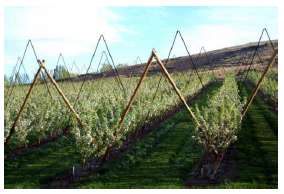
Vertical trellis
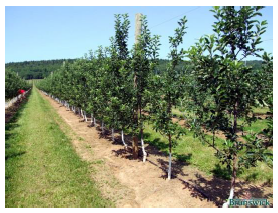
Variety. Variety and ‘named variety’ are commonly used to mean the same as cultivar. Technically, variety means a naturally occurring variant of a species.
Vigor. Refers to amount and rate of growth; relative among cultivars, climates and horticultural practices.
Stay up to date
Receive email notifications about Northwest and global and agricultural and economic perspectives, trends, programs, events, webinars and articles.
Subscribe